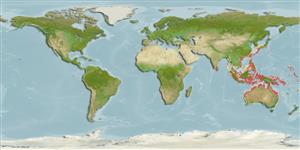Environment: milieu / climate zone / depth range / distribution range
Ecología
marino; salobre bentopelágico; no migratorio; rango de profundidad 2 - 10 m (Ref. 90102). Tropical
Indo-West Pacific: Nicobar Islands to New Guinea and northern Australia, north to Ryukyu Islands.
Tamaño / Peso / Age
Maturity: Lm ? range ? - ? cm
Max length : 25.0 cm TL macho / no sexado; (Ref. 37107); common length : 9.3 cm TL macho / no sexado; (Ref. 394)
Espinas dorsales (total): 13 - 14; Radios blandos dorsales (total): 9-11; Espinas anales 3; Radios blandos anales: 5.
Occurs inshore (Ref. 7300); on rocky reefs and rubble bottoms in shallow coastal waters. Feeds on small fishes, shrimps, and crabs during the day. Occasionally enters the aquarium trade (Ref. 37107). Also found in brackish estuaries and silty coastal reefs (Ref 90102).
Life cycle and mating behavior
Madurez | Reproducción | Puesta | Huevos | Fecundidad | Larva
Paxton, J.R., D.F. Hoese, G.R. Allen and J.E. Hanley, 1989. Pisces. Petromyzontidae to Carangidae. Zoological Catalogue of Australia, Vol. 7. Australian Government Publishing Service, Canberra, 665 p. (Ref. 7300)
IUCN Red List Status (Ref. 130435)
Threat to humans
Harmless
Human uses
Pesquerías: escaso valor comercial
Más información
Nombres comunesSinónimosMetabolismoDespredadoresEcotoxicologíaReproducciónMadurezPuestaAgregación para la puestaFecundidadHuevosEgg development
ReferenciasAcuiculturaPerfil de acuiculturaRazasGenéticaElectrophoresesheritabilidadEnfermedadesProcesamientoNutrientsMass conversion
ColaboradoresImágenesStamps, Coins Misc.SonidosCiguateraVelocidadTipo de nataciónSuperficie branquialOtolitosCerebrosVisión
Herramientas
Special reports
Download XML
Fuentes de Internet
Estimates based on models
Preferred temperature (Ref.
123201): 24.7 - 29.3, mean 28.6 °C (based on 2453 cells).
Phylogenetic diversity index (Ref.
82804): PD
50 = 1.5000 [Uniqueness, from 0.5 = low to 2.0 = high].
Bayesian length-weight: a=0.01349 (0.00516 - 0.03528), b=3.04 (2.81 - 3.27), in cm total length, based on LWR estimates for this (Sub)family-body shape (Ref.
93245).
Nivel trófico (Ref.
69278): 3.9 ±0.67 se; based on food items.
Fishing Vulnerability (Ref.
59153): Low vulnerability (15 of 100).
Nutrients (Ref.
124155): Calcium = 147 [81, 264] mg/100g; Iron = 0.976 [0.598, 1.654] mg/100g; Protein = 18.2 [17.3, 19.1] %; Omega3 = 0.221 [0.117, 0.409] g/100g; Selenium = 37.8 [18.7, 70.2] μg/100g; VitaminA = 37.1 [14.6, 94.1] μg/100g; Zinc = 1.84 [1.33, 2.61] mg/100g (wet weight);
